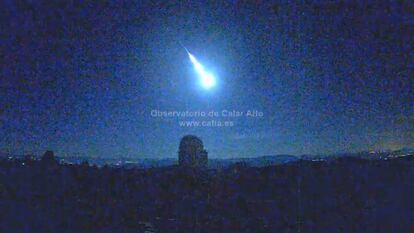A fireball “turned night into day” in Spain this weekend
Observatories in Toledo, Granada and Seville recorded the entry of a fragment of the Encke comet over the southeast of the peninsula in the early hours of Saturday morning
A fragment of the Encke comet created a huge ball of fire over southeast Spain over the weekend, as it entered the Earth’s atmosphere at more than 100,000km/h. That’s according to a Facebook post from the Astrohita Foundation, which observed the phenomenon from the astronomical complex in La Hita, in the province of Toledo.
The fireball was visible from more than 400 kilometers away
The event was recorded at 12.46am on Saturday November 3, when a “ball of fire that shone brighter than the full Moon flew over the south of the country,” Astrohita wrote in its social media post. The luminosity was so unusually high that nighttime in the southeast of Spain turned into day for an instant.”
Despite the cloud cover at the time in the area, the phenomenon was registered by detectors at Huelva University, as well as observatories in La Sagra (Granada), Sierra Nevada (Granada) and Seville.
These detectors are part of so-called Project Smart, which aims to continuously monitor the skies to register and study the impact of rocks coming from the Solar System on the Earth’s atmosphere.
The analysis carried out by the researcher in charge of the project, Professor José María Madiedo, from Huelva University, established that the impact took place 122 kilometers above the Mediterranean Sea, off the coast of Almería, moving in a northwesterly direction, eventually extinguishing around 63 kilometers above the municipality of Pueblo Blanco (Almería).
The fireball was visible from more than 400 kilometers away.
Fragments from the Encke comet are mostly smaller than a grain of sand, and coincide with the Earth during the months of October and November, producing a series of meteor showers known as the Taurids.
However, the fragment that caused the fireball on November 3 was much bigger, measuring almost a meter across, which is why its impact against the atmosphere produced an unusually bright phenomenon.
English version by Simon Hunter.
Tu suscripción se está usando en otro dispositivo
¿Quieres añadir otro usuario a tu suscripción?
Si continúas leyendo en este dispositivo, no se podrá leer en el otro.
FlechaTu suscripción se está usando en otro dispositivo y solo puedes acceder a EL PAÍS desde un dispositivo a la vez.
Si quieres compartir tu cuenta, cambia tu suscripción a la modalidad Premium, así podrás añadir otro usuario. Cada uno accederá con su propia cuenta de email, lo que os permitirá personalizar vuestra experiencia en EL PAÍS.
¿Tienes una suscripción de empresa? Accede aquí para contratar más cuentas.
En el caso de no saber quién está usando tu cuenta, te recomendamos cambiar tu contraseña aquí.
Si decides continuar compartiendo tu cuenta, este mensaje se mostrará en tu dispositivo y en el de la otra persona que está usando tu cuenta de forma indefinida, afectando a tu experiencia de lectura. Puedes consultar aquí los términos y condiciones de la suscripción digital.











































